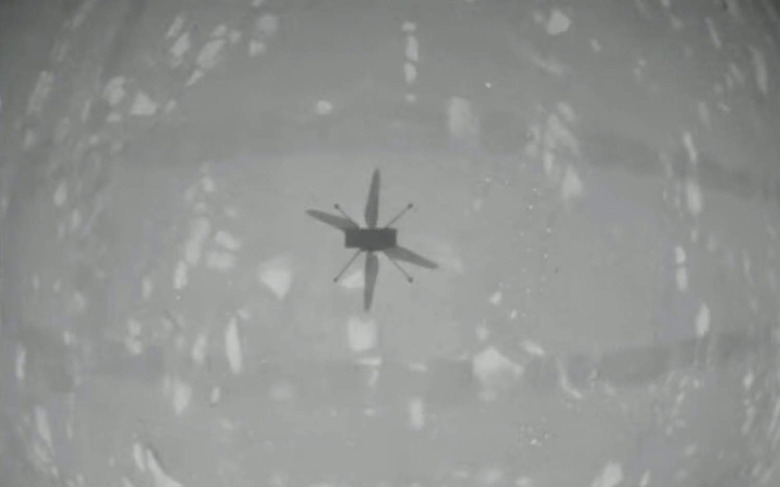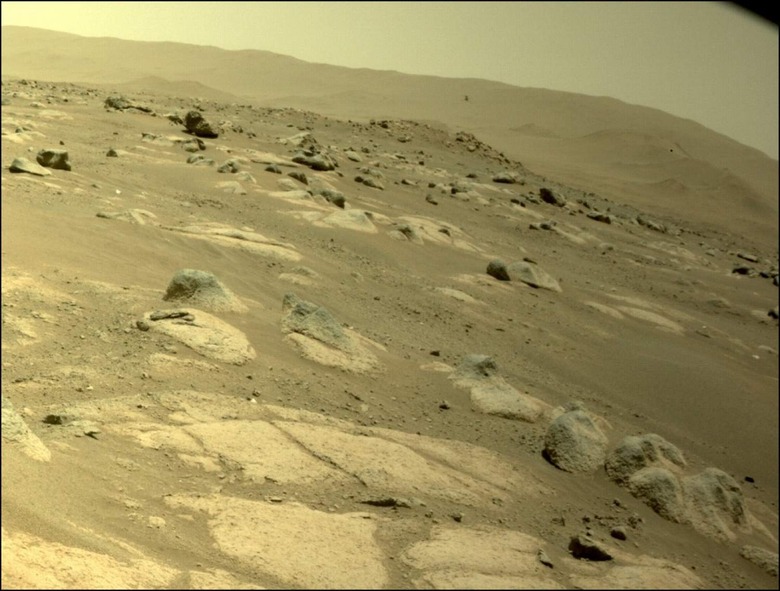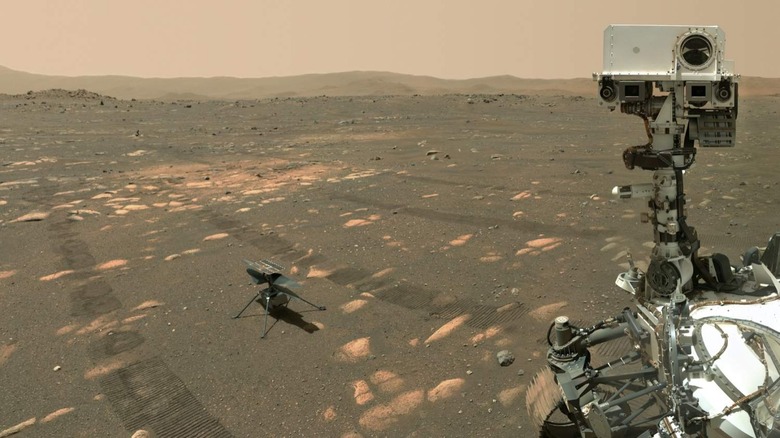NASA's Mars Helicopter And Perseverance Rover Are Teaming Up For A Buddy Mission
NASA's Ingenuity may have seen some delays in its fourth flight, but with that safely under its belt the Mars helicopter's next big missions have been revealed. The fourth mission for the historic aircraft was its most ambitious yet, tapping its dual cameras to underscore how valuable an eye in the sky could be to future space missions. Still, even more adventures alongside the Perseverance rover are yet to come, NASA has confirmed.
Having traveled to Mars in the belly of the rover, Ingenuity has already had an adventure-packed month. Its first flight test demonstrated that the dual-rotor aircraft was, indeed, capable of powered, controlled flight on the planet, despite the differences in gravity and air density.
NASA and the Jet Propulsion Laboratory (JPL) in California which is responsible for managing both rover and helicopter followed that inaugural flight with two further missions, each cranking up the challenges. Ingenuity showed it could fly higher, and further, each time, with Perseverance observing with its MastCam-Z cameras from across Jezero Crater. For the fourth flight, though, it was to be cameras on Ingenuity itself that were the star attraction.
Ingenuity Flight Four started with the helicopter climbing to 16 feet above the planet's surface. It was then to fly south, over rocks, sand ripples, and small impact craters, until it was 276 feet from its launch position. After that, it would fly a further 150 feet, with the down-facing navigation camera used to snap images every 4 feet of the ground underneath.

Ingenuity was then to hover, and use the color camera to capture images, before heading back to its original launch position. That's been named Wright Brothers Field, in honor of the first powered flight on Earth.
The mission was to encompass a number of extra hurdles over the first three. Not only would time airborne increase, with NASA expecting it to take almost two minutes in total, the maximum airspeed was to increase to 8 mph from the previous 4.5 mph maximum. Total flight range would also more than double.
JPL's original plan was for that to take place on Thursday of this week, April 29. Ingenuity was programmed with the flight details – since the latency between Earth and Mars is too great for the JPL team to pilot the helicopter manually, in real-time – but when the data started to return from the scheduled downlink, it turned out that the takeoff never actually happened.
"The helicopter is safe and in good health," the JPL team said on Thursday. "Data returned during a downlink at 1:21 p.m. EDT (10:21 a.m. PDT) indicates the helicopter did not transition to flight mode, which is required for the flight to take place."
The mission was rescheduled for today, and went without a hitch. "[The] Mars helicopter completed its 4th flight, going farther & faster than ever before," the JPL team tweeted. "It also took more photos as it flew over the Martian surface. We expect those images will come down in a later data downlink, but Perseverance's Hazcam caught part of the flight."

Ingenuity Missions Five and Six: Time to prove your worth
With four flights under its metaphorical belt, Ingenuity's responsibilities are getting upgraded. NASA has added an operations demonstration to the mission, "exploring how aerial scouting and other functions could benefit future exploration of Mars and other worlds."
It'll begin with the helicopter's sixth flight. The fifth mission will see Ingenuity launch out on a one-way trip, landing at a new site from which it will support Perseverance as the rover begins its own scientific experiments. The team responsible for that are already building a shortlist of locations for rock and sediment sampling, as Perseverance begins its hunt for ancient microscopic life.

Already, it has moved from its original location to a new area identified as a potentially good place to start sampling. Still, that's only 33 feet of driving, and there's more travel on the cards soon. "We'll spend the next couple of hundred sols executing our first science campaign looking for interesting rock outcrop along this 2-kilometer (1.24-mile) patch of crater floor," Ken Farley, project scientist for the Perseverance rover from Caltech in Pasadena, California, said of the move, "before likely heading north and then west toward Jezero Crater's fossil river delta."
Ingenuity's role will be to provide aerial reconnaissance. The helicopter could fly ahead to the next destination on Perseverance's roadmap, delivering photos back to NASA and the JPL that could help identify possible science targets, highlight routes the rover might take, and even flag inaccessible features or possible hazards. Stereo imagery could be used for digital elevation maps.
Flights for Ingenuity will slow, it's expected, from the cadence of every few days that NASA has kept up so far, to once every two to three weeks. They'll also be done with maximum safety in mind: Ingenuity can take risks, as its primary goal of proving successful flight has been met, but NASA isn't chancing a crash or similar accident damaging Perseverance itself. Even if something does go wrong, that won't derail the rover project: "these scouting flights are a bonus," NASA points out, "and not a requirement for Perseverance to complete its science mission."
Still, there's a deadline on the calendar all the same. The goal is to wrap up flight operations by the end of August, ahead of the solar conjunction in mid-October. At that point, Mars and Earth will be on opposite sides of the Sun, meaning that there'll be no communication between NASA, the rover, or the helicopter.
